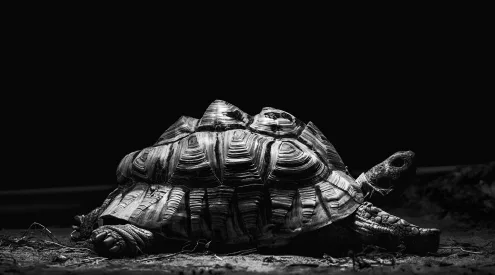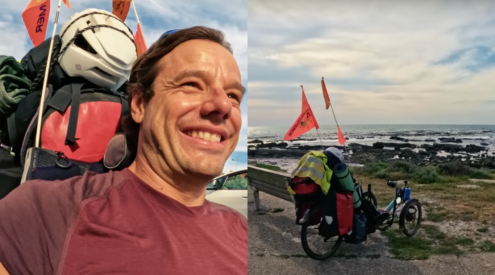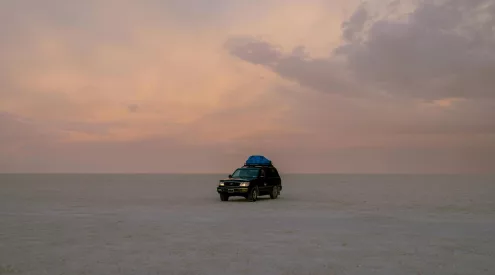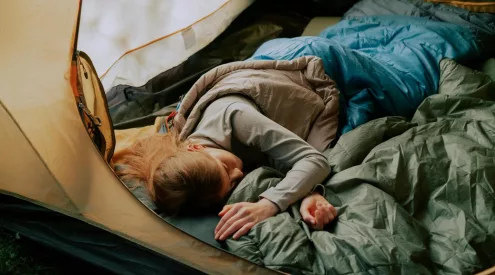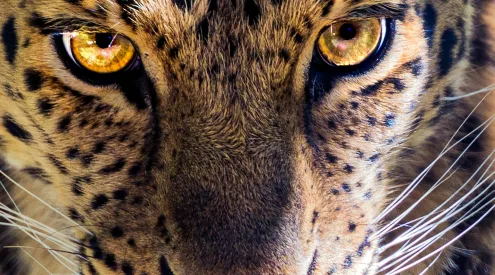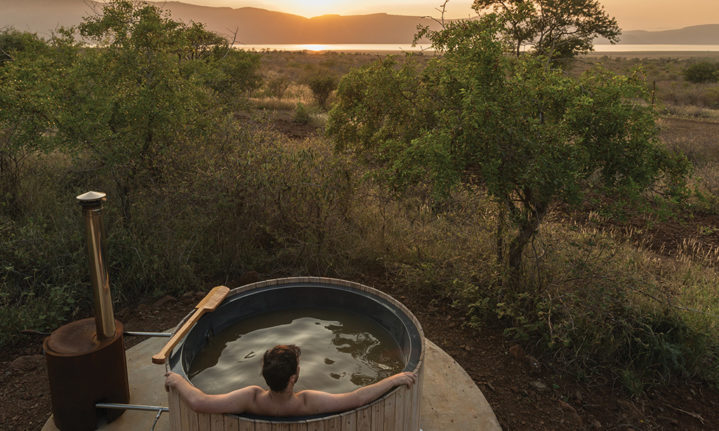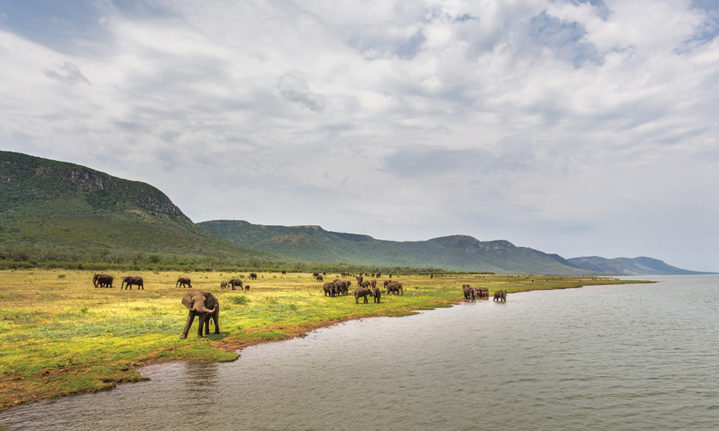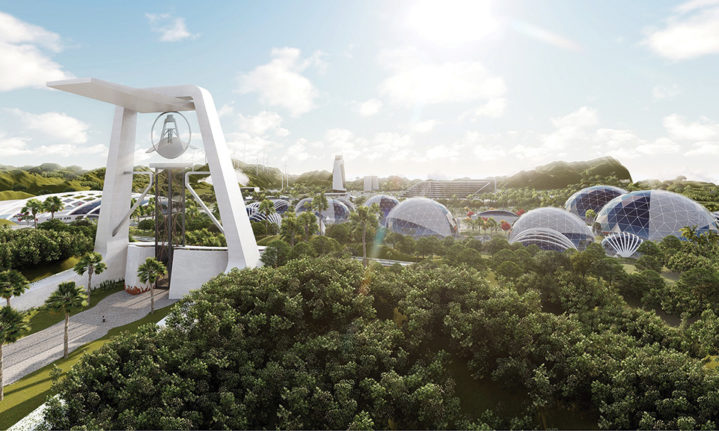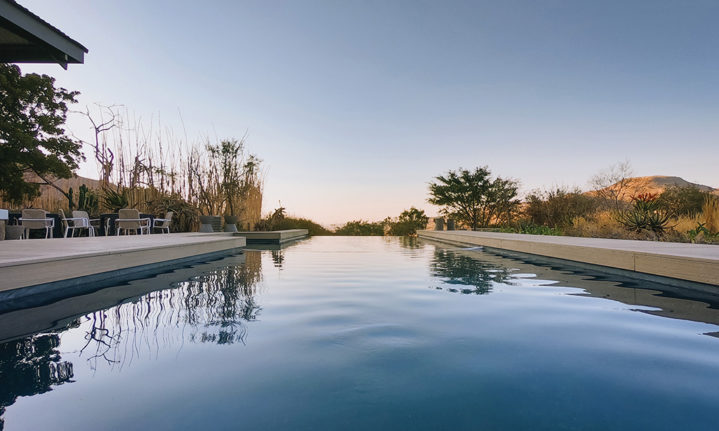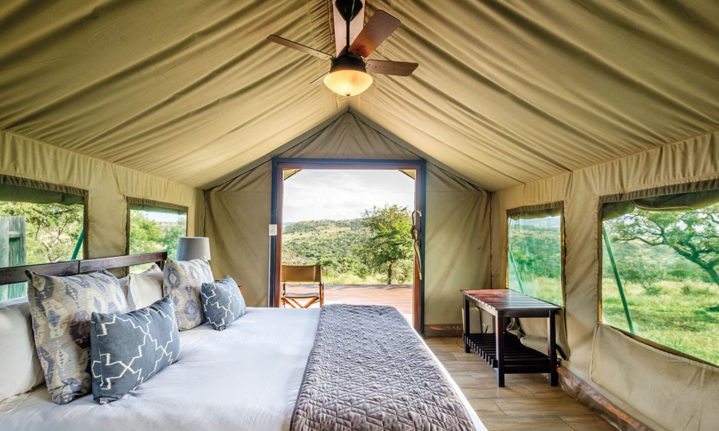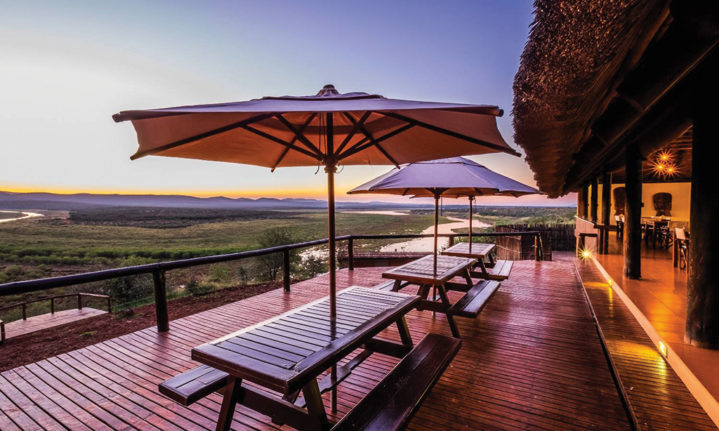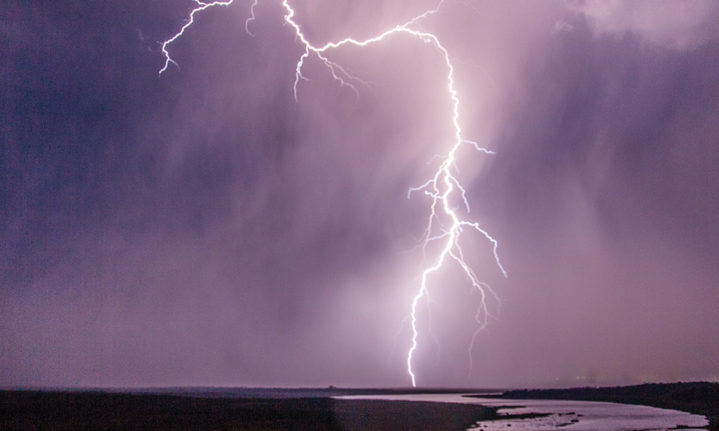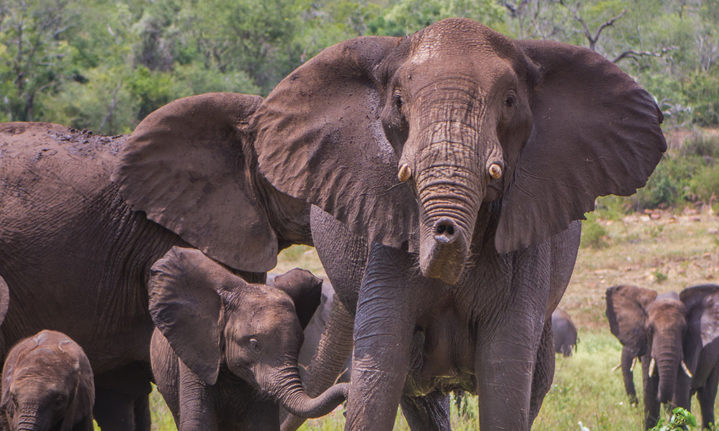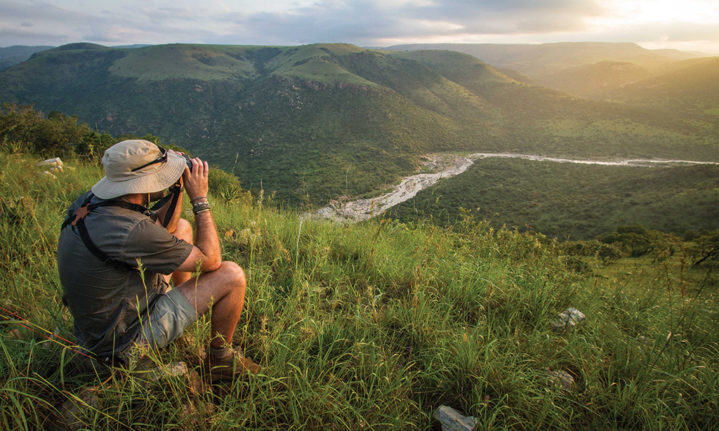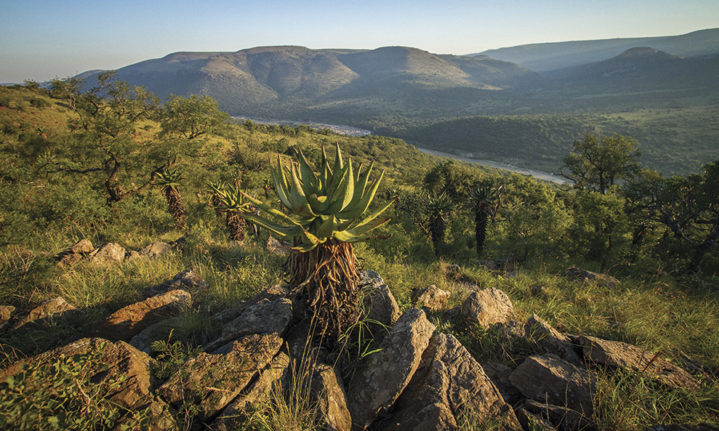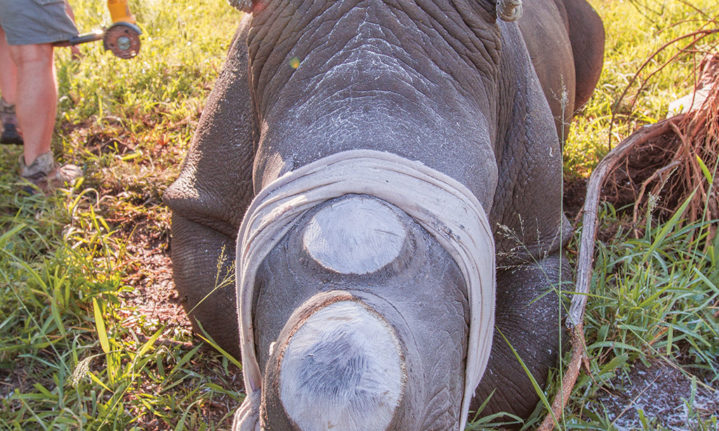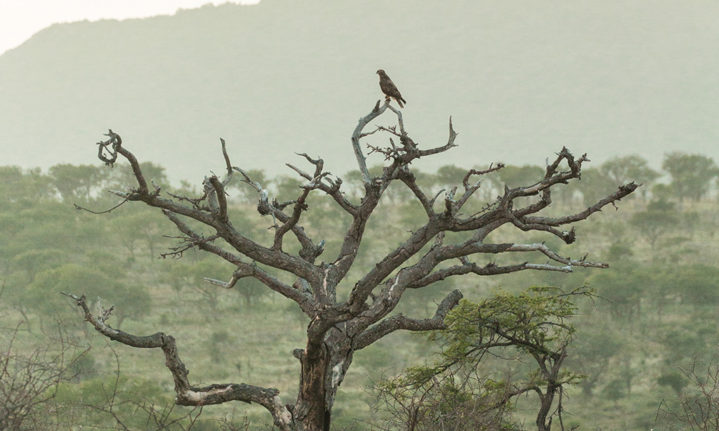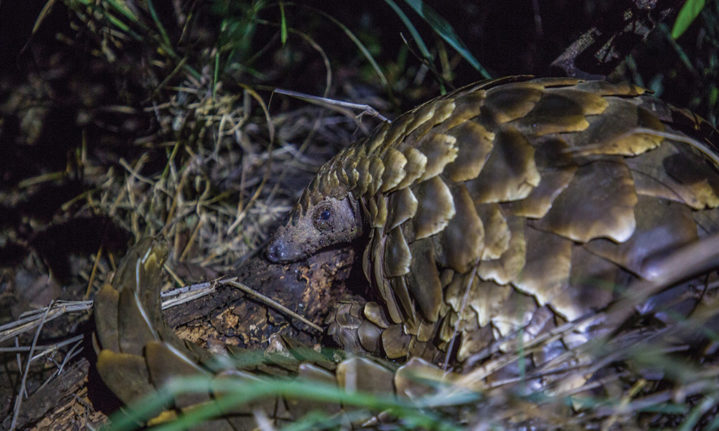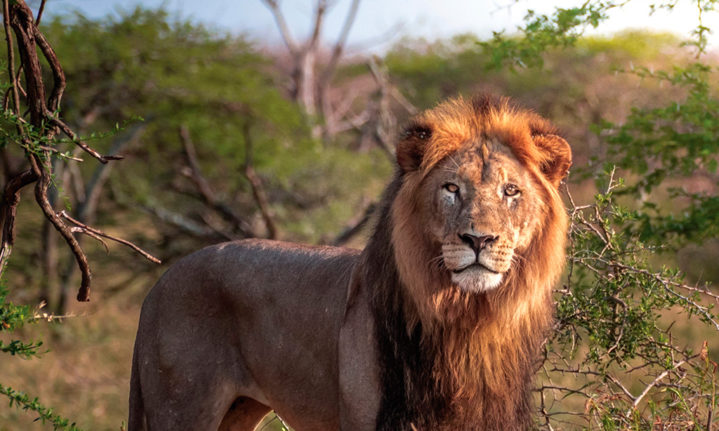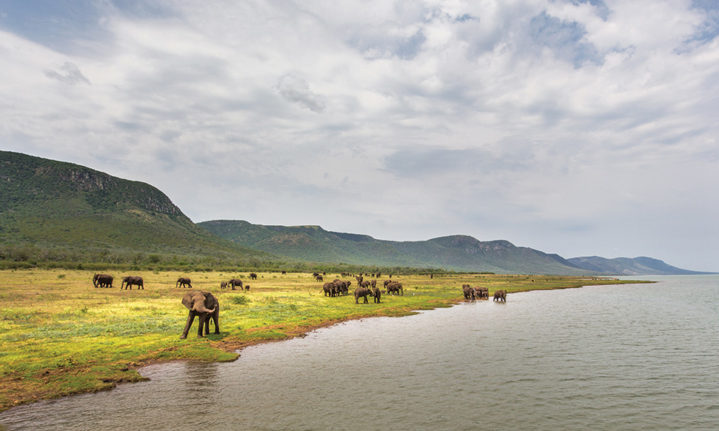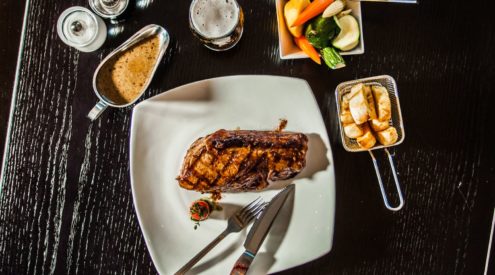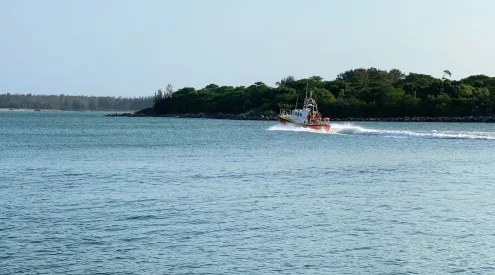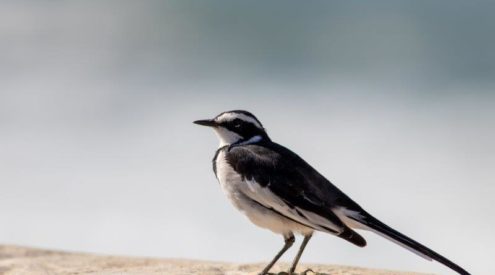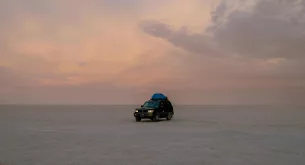There are a string of lesser-known game reserves in Northern KwaZulu-Natal that offer some of the most intimate and thrilling wildlife encounters in the country – think pangolin walks, camping in unfenced Big Five country and elephant-monitoring boat safaris. Add these six to your game-reserve itinerary.
Words & Photos Matthew Sterne
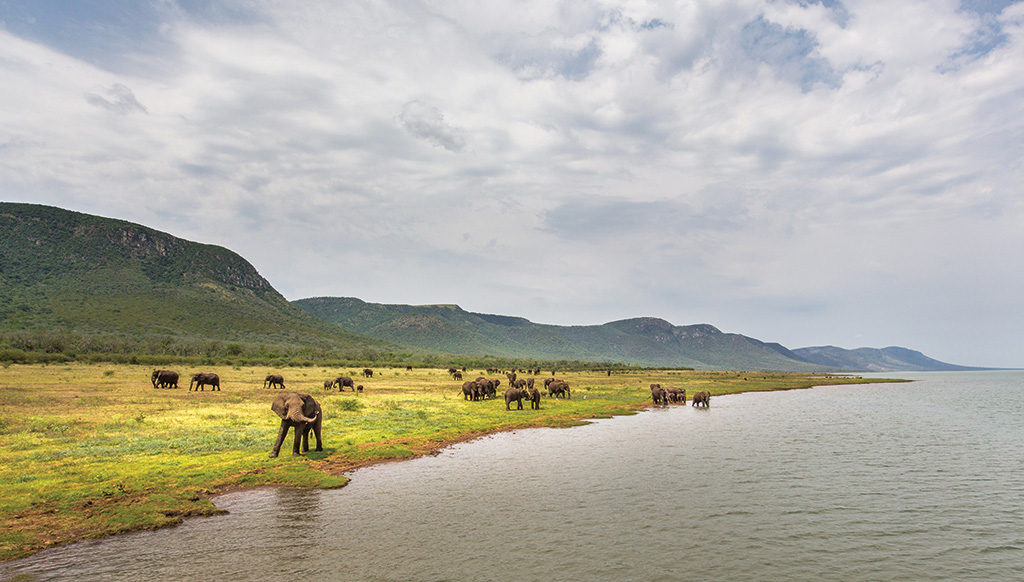
The elephants of Lake Jozini used to inhabit the southern section of the Pongola Game Reserve, but during a drought in 2016, they crossed the Pongola River into the area below the Lebombo Mountains, where they’ve been ever since.
It was close to midnight when we stepped off the bakkie. The full moon was nearing its zenith allowing us to make out the silhouette of Manyoni Private Game Reserve’s vegetation. ‘Listen,’ reserve manager Karen Odendaal said. On the other side of the bushes came the sound of rustling, branches breaking and scraping so loudly it seemed almost reckless. ‘Is that the buffalo?’ I whispered. We’d encountered a disgruntled dagga boy moments before and there was a chance he was still wandering around. ‘No,’ Karen said, ‘that’s the pangolin.’ The four of us sniggered at the absurdity of the sound, but also at the excitement of finally spotting this ancient animal for the first time.
Telemetry had taken us that far, our feet would need to take us a little further. We stepped through the brush and found the pangolin face first in a broken tree stump. Big claws stuck out from the side of a hide like a giant pine cone. Ants scampered everywhere while a long tongue flickered in and out. The pangolin’s movements made me think of one writer’s description, ‘If the pangolin went to high school, it would be the drama geek – elusive, nocturnal, rarely appreciated and barely understood.’
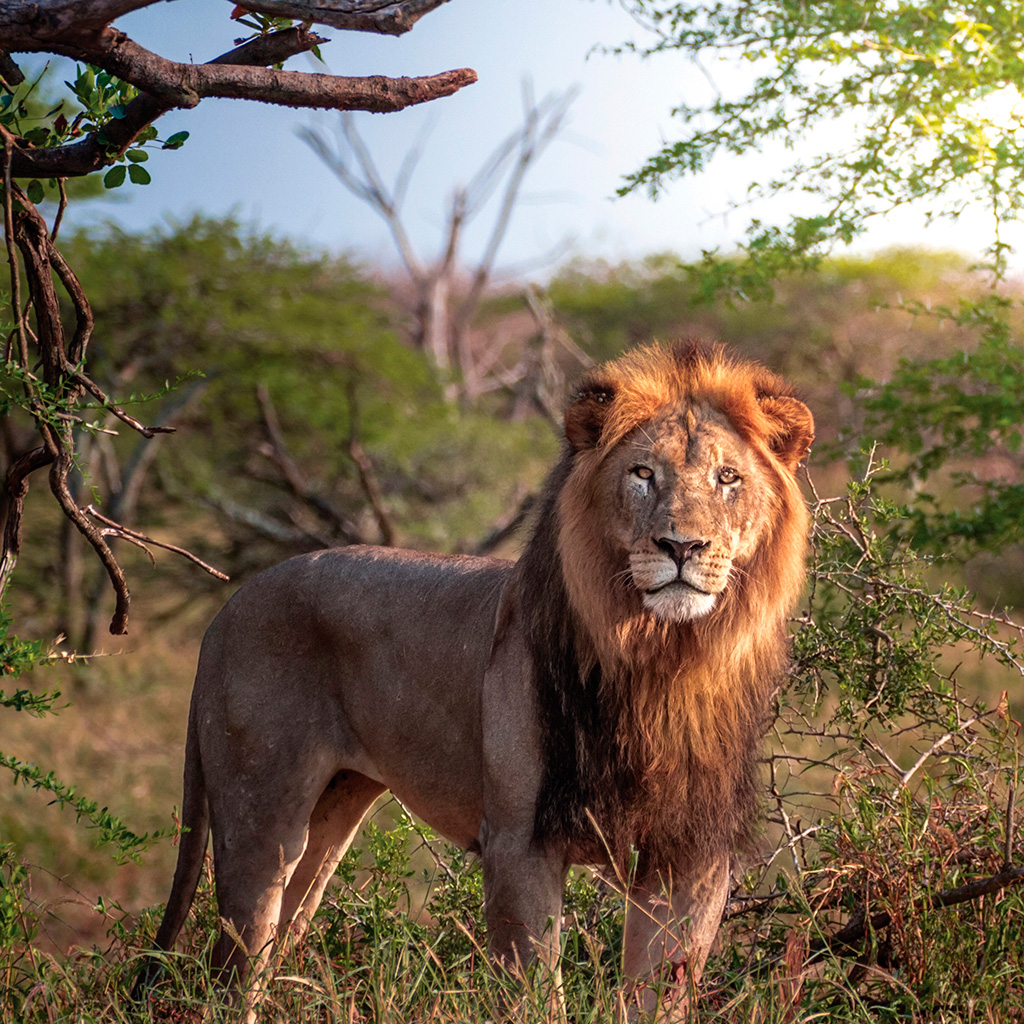
Manyoni has a healthy population of lion and one of the highest metapopulations of cheetah in the country.
He carried on slurping, like a kid with a milkshake, the bounty of ants too tantalising to overlook. We watched this wonderfully unique creature in quiet admiration, before getting down to the business of changing his tracking device.
Manyoni only introduced pangolins this year, but the reserve continues an established culture of focusing on fringe species. Their motto is ‘Saving endangered species for endangered spaces,’ Karen told me the next day. ‘And that’s why we focus on black rhino, wild dogs, cheetah and pangolins. And also smaller creatures like red-billed oxpeckers, brown hyenas and leopard tortoises. Species that are on the cusp of falling out of the system all together,’ she added.
Manyoni builds on a rich history of conservation in Zululand. Most famously, Operation Rhino, headed by Dr Ian Player in the 1960s, started it all. And the Black Rhino Expansion Project has continued in a similar vein since 2005. I was in the area to find game reserves that have a specific conservation focus and aren’t as well known as nearby Hluhluwe-iMfolozi and Phinda. Turns out, there’s a remarkable collection of them that lie between the Tugela River and Mozambique, offering unique wildlife outings at surprisingly affordable rates. These unfiltered and immersive encounters are described as ‘transformative experiences’, a travel trend that has been predicted to surge in the coming years. I was keen to unearth the offerings.

Rescued pangolins are slowly establishing themselves in Manyoni, for the first time in 70 years.
Somkhanda Game Reserve, just 40 kilometres from Manyoni, is a perfect example of this. Once rhinos were introduced through the Black Rhino Expansion Project in 2008, more vital species followed. Today, it’s a Big Five reserve. Guests can experience a range of monitoring activities such as tracking wild dogs and rhino dehorning. Lately, however, it’s the rustic unfenced campsite – one of the few in a Big Five reserve in South Africa – that’s been its biggest hit. Night-roaming leopards and the resident lion pride pass through the camp, and elephants often stop by in search of water.
‘A lot of people come here as a recce to test their gear before they go on a big overland trip,’ lodge manager Lundy Bredberg told me. There are 20 kilometres of challenging 4×4 tracks – an attraction in its own right. ‘You won’t see another vehicle here. If you have a sighting it’s just gonna be you and the animals,’ Lundy says.
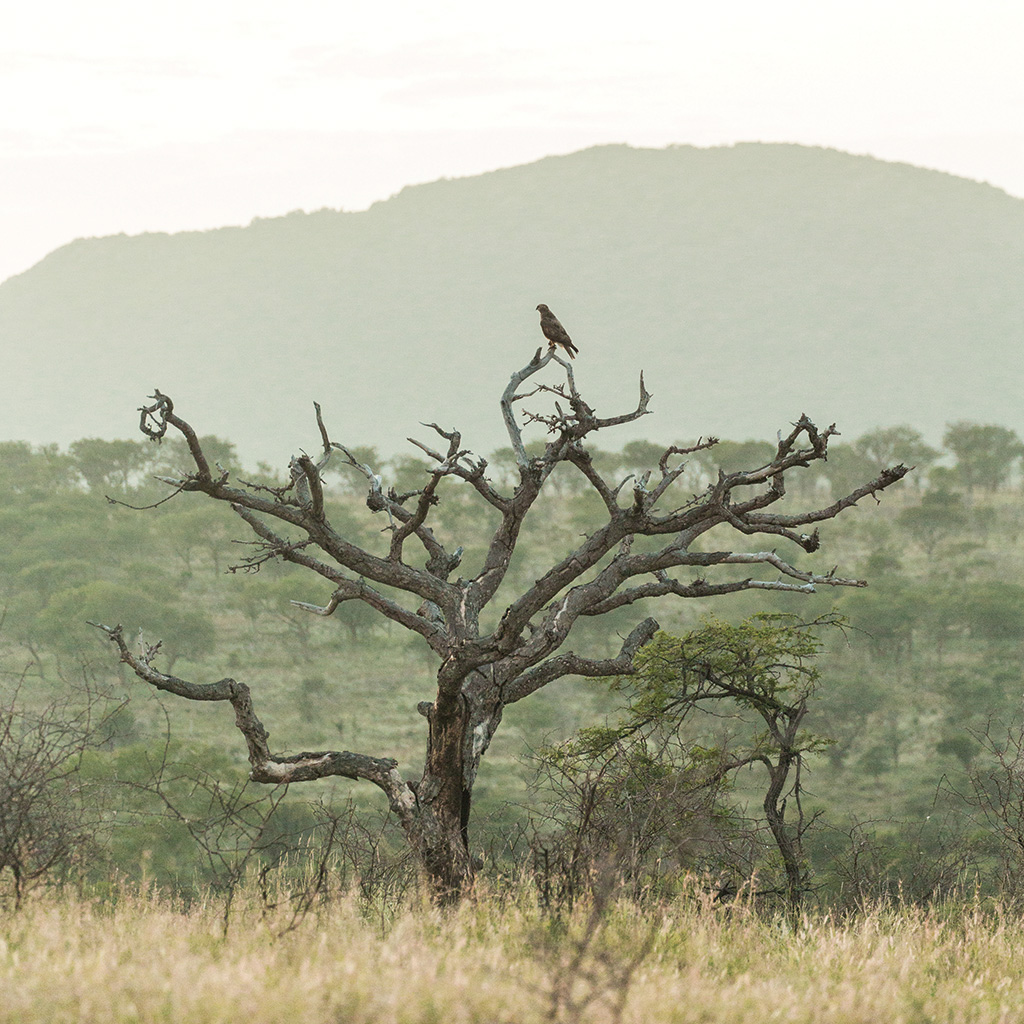
Tawny, Wahlberg’s and brown snake eagles are common in Zululand.
As my journey unfolded, each of the reserves impressed in their own way. The family-friendly Bonamanzi, near Hluhluwe-iMfolozi Park, has 35 kilometres of self-driving trails where guests can see four of the Big Five (no lion). Ndumo Game Reserve has similar trails, but the birding walks are by far the best activity here. With 427 species, it has almost as many bird species as Kruger National Park, which is 200 times larger.
Maybe the most interesting of all the parks I visited was the recently launched Babanango Game Reserve. Two lodges and a superb outdoor education centre have been completed in a landscape of spectacular views and sprawling grasslands, with another two lodges in the pipeline. It’ll hold the Big Five, as well as cheetahs and wild dogs within three and a half years, and the intention is to offer fly-camp sleepouts, canopy tours, horse riding and mountain biking.
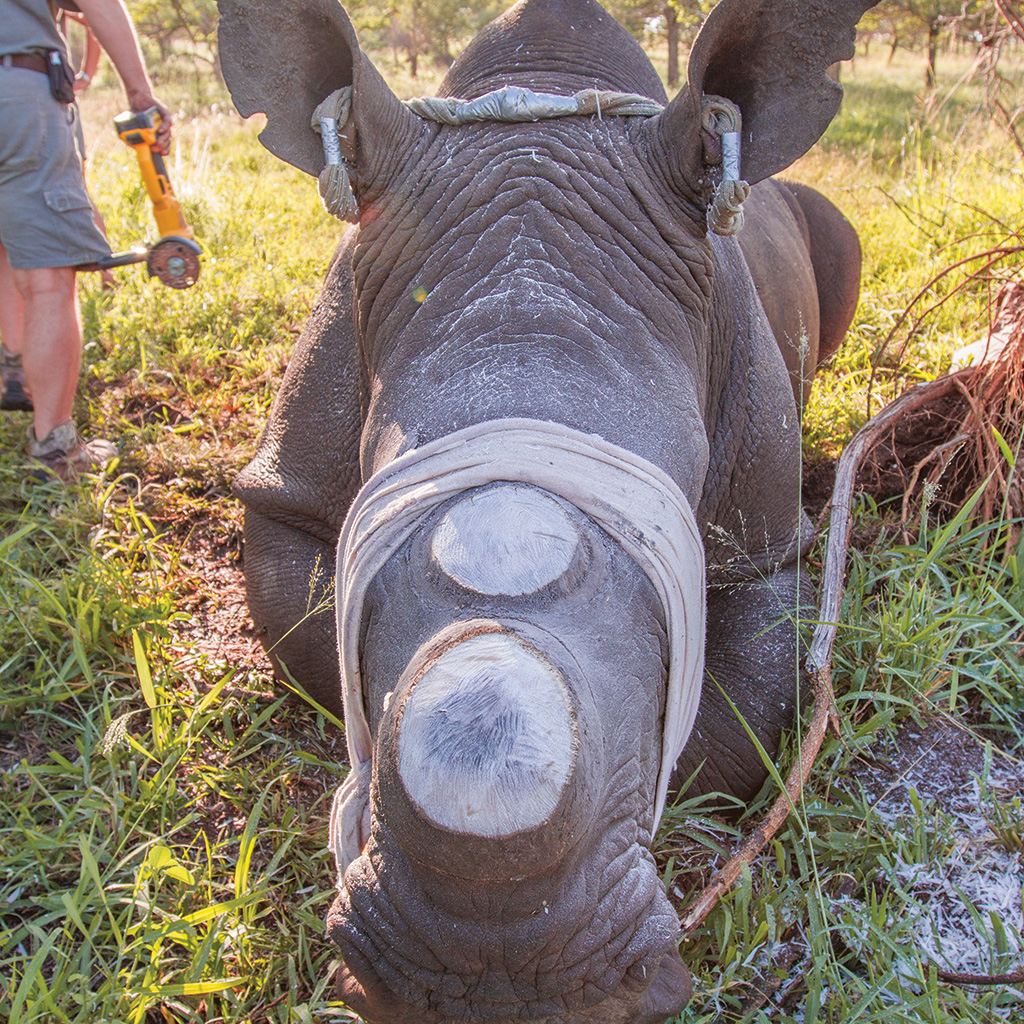
Rhino dehornings have become widely practiced in Zululand. Witnessing one is both uplifting and emotional and can be arranged at either Somkhanda or Manyoni.
One of my last stops was at the White Elephant Bush Lodge in Pongola Game Reserve. It overlooks Jozini Dam which is home to over 900 crocodiles. On the far side of the dam loom the Lebombo Mountains, lush and imposing. I joined passionate and knowledgeable elephant monitor Suzette Boshoff one morning on a boat trip across the dam. After an hour we drew near the shore, timing our arrival perfectly with eight elephants wandering out of the undergrowth. ‘They come down to the water every morning at 11. It’s like clockwork, they’re very punctual,’ Suzette said. ‘We see the elephants on 90% of our boat safaris and large herds about half of the time.’
We approached the elephants silently, slowly idling towards them as we readied our cameras a few metres offshore. Out of the trees more elephants appeared and we watched, in hushed awe, as they kept coming. ‘These are two different herds,’ Suzette said. ‘They’re merging.’ Half an hour later, there were 60 elephants in front of us. While the babies slipped in the mud and adolescents wrestled in the water, the matriarch approached us, sniffing the air suspiciously.
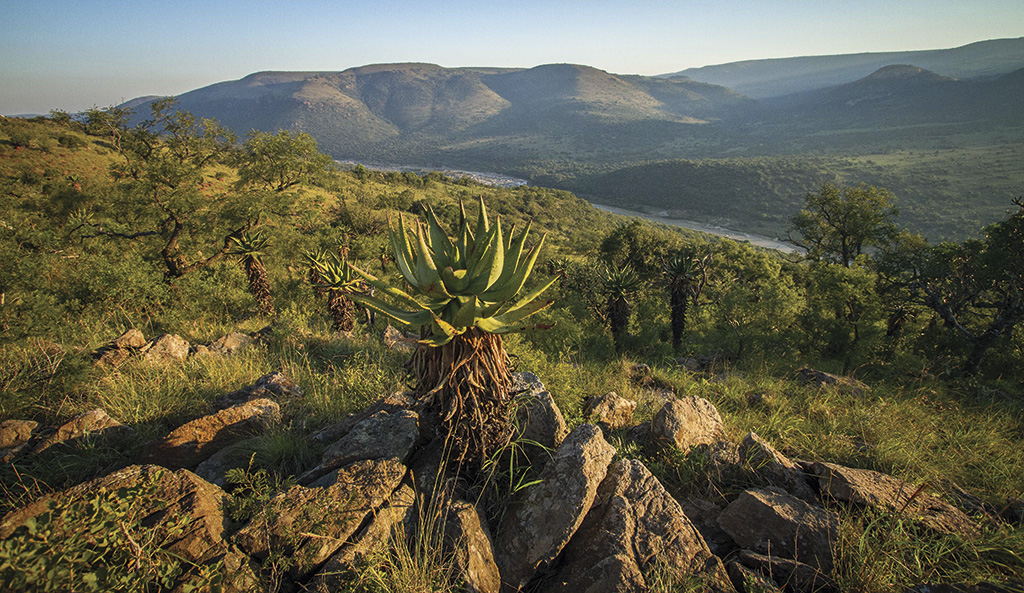
Babanango has spectacular viewpoints throughout the reserve.
What makes these big-herd sightings even more special is their history. In 1997, exactly 100 years after an elephant was last seen in the region, 17 elephants were reintroduced into the reserve from Kruger. Today, there are nearly 100 in the biosphere, a collection of three game reserves that fringe the lake – Pongola Game Reserve, Pongola Nature Reserve and Royal Jozini in neighbouring Eswatini.
The breeze pushed us past them slowly, then we’d chug upstream and drift past again. The morning sun lit up the Lebombo Mountains behind them so beautifully it seemed like an orchestrated theatre production. As we left, we all let out an audible sigh, as if all thinking the same thing: what had we just witnessed?
I’d experienced similar thoughts throughout my trip. Do people know that Manyoni is almost on par with the Sabi Sand experience (bar the leopard) at a fraction of the price? Have the hardcore campers found out that a Big Five wilderness camping experience is on offer at Somkhanda? And how is the elephant experience at Pongola not on every wildlife-lover’s bucket list? With the Drakensberg not far away, amazing beaches on the coast and the rolling Zululand hills as a backdrop, this area of South Africa might just offer the best holiday in the country. As I headed back to King Shaka airport at the end of an unforgettable two-week trip, I was left with one last question: when can I go back?
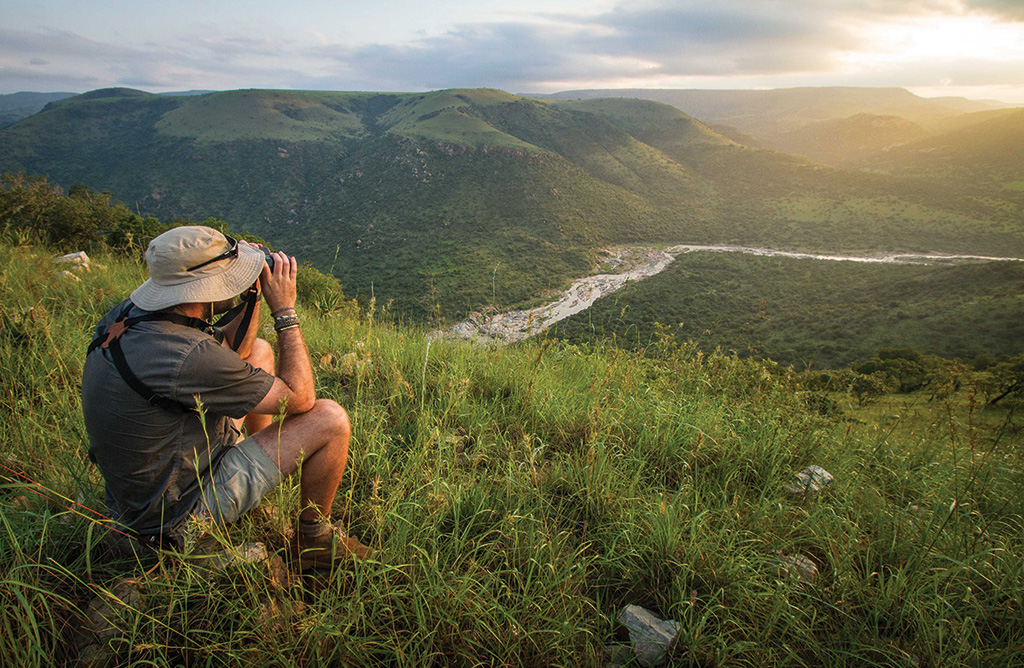
Recent studies have reported high biodiversity levels in Babanango Game Reserve due to its threatened vegetation types and species, and high levels of endemism and habitat heterogeneity. Part of this diversity is owed to its 23 kilometres of river frontage on the White Umfolozi River. Photo by Chris Galleries
A Birding Hotspot
North Meets South
Northern KZN is at the northern limit for many southern species and the southern limit for many East African species. Throw in the wetland varieties and you get one of the richest birding areas in Africa. Each of the reserves boasts remarkable bird numbers.

Monitors keep an eye on the elephants throughout the day.
‘The most ambitious conservation project ever’
What is it?
Noah’s Ark, a cutting-edge reserve planned
in Zululand, aspires to create safe havens for threatened species from around the world. Through temperaturecontrolled geodomes, they hope to replicate climate conditions
from all the major
ecosystems. The
reserve has a projected cost of R100 billion.

What can we expect?
The plans are certainly ambitious. The
aquarium will be the biggest in the world, while the geodomes will use smart glass and
sophisticated climate control systems. The Polar Dome is the most challenging of these, which aims to replicate Arctic conditions.
Construction is due to begin in 2021, with the aim of completing it within five years.

Trip Planner
Getting There
Most of the reserves are along the N2, east of Durban. The closest, Bonamanzi, is three hours from the city, with Pongola the furthest at four hours.
Stay Here
Bonamanzi Game Reserve
Best For
Quick family breaks
Just three hours from Durban, Bonamanzi is a good weekend destination. Young kids will love the tame warthog, impala and nyala that walk around the 4 000-hectare reserve.
Do
A sunset cruise on the river will take you into the False Bay Estuary to see crocodiles, hippos and many birds. From R450 pp.
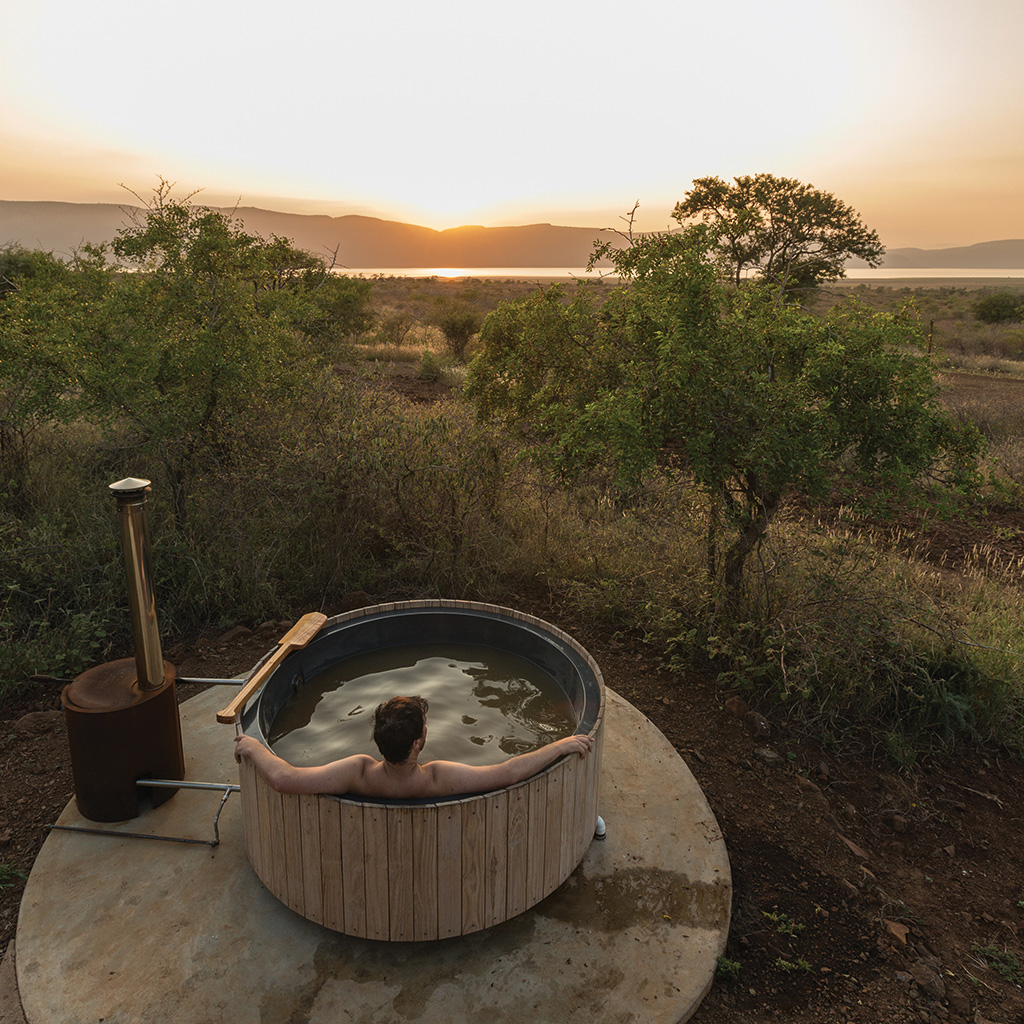
Waterbuck often drink from the hot tubs at White Elephant Africamps.
Stay
There are 24 powered campsites (from R200 pp); 10 thatched rondavels look onto Lalapanzi Dam (from
R1 295 pp), self-catering treehouses in the forest (from R750 pp), and
three exclusive-use villas, good for private groups (from R850 pp).
Fact
The reserve consists mostly of sand forest, with small pockets of wetlands and savannah, and borders the Hluhluwe River.
Ndumo Game Reserve
Best For
Birding
Near Tembe Elephant Park on the Mozambique border, Ndumo was created in 1924 to provide a refuge for hippo. The birdlife is best seen on
one of the guided walks around the beautiful pans, ringed by fever trees and sycamore figs, or on
a river walk.
Do
All three of the walking trails take around three hours and start in the morning. The Pongola River and sand forest trail offers the best chance at seeing a Pel’s fishing owl, southern-banded snake eagle and African broadbill. Nyamithi Pan is best for water birds and waders. Shokwe Pan is a good
spot for narina trogon, twinspots and bant-necked romula. R170 pp.
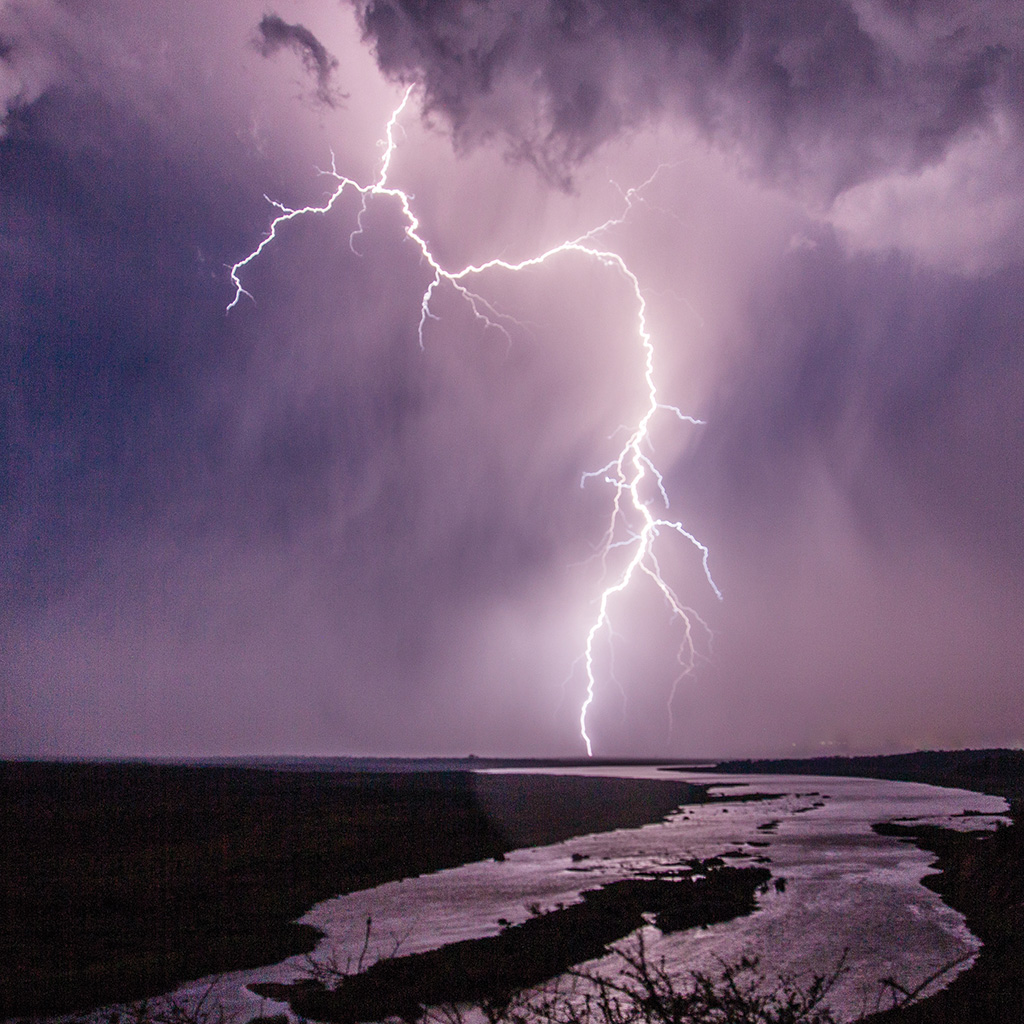
Electrifying scenes from Nkwazi Lake Lodge.
Stay
There are 14 shaded campsites with power outlets and braai
stands, from R140 pp.
The self-catering
cottages come with two beds, a kitchenette, a small deck and a braai stand on the grass outside. From R500 pp.
Fact
About a third of the reserve is covered by the spiky mahemane bush, which was described by infamous hunter-explorer Frederick Courteney Selous as the thickest bush he ever encountered in Africa.
Manyoni Private Game Reserve
Best For
Predator sightings
Manyoni was formed in 2005 from a collection of farms, hunting reserves and eco lodges, involving 17 landowners. When lions were introduced six years later, Manyoni became a Big Five reserve. Today, there are over 30 lions on the 23 000-hectare property and little sign of previous farming activity. In fact, the stunning landscape is one of its best features.
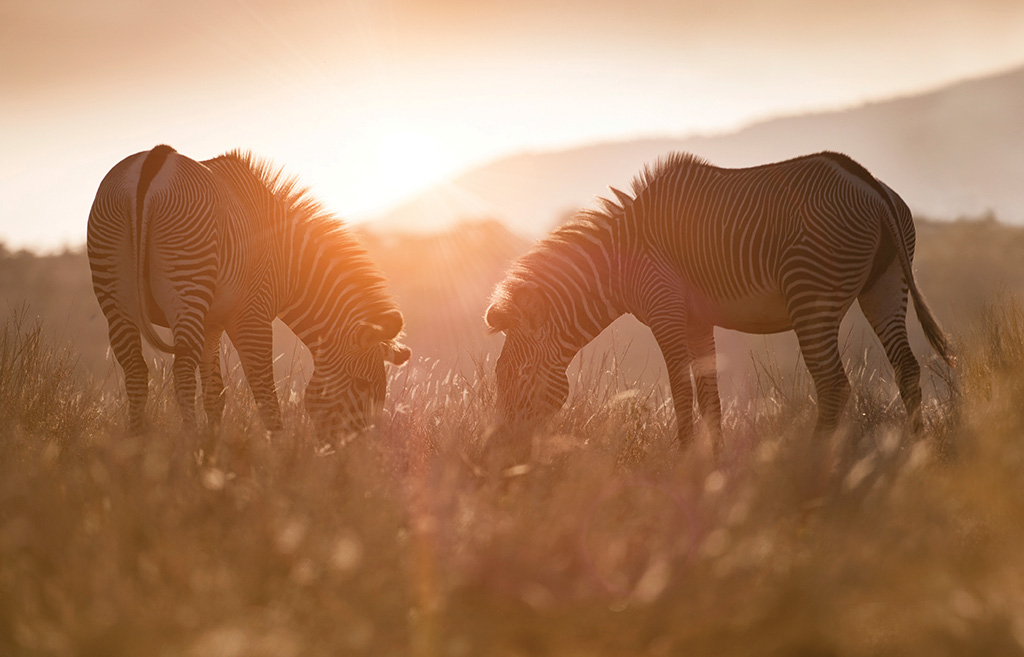
Manyoni was formed in 2005 from a collection of farms, hunting reserves and eco lodges, involving 17 landowners.
Join Manyoni’s wild-life management team on a rhino dehorning experience, R1 200 pp. You can also go on a wildlife monitoring session, where you’ll learn about the use of telemetry equipment and track one of the collared elephants, lions, cheetahs or wild dogs. R750 pp. Pangolin tracking takes place at night if conditions are right. R1 200 pp.
Stay
Bayete Zulu private lodge, with just three chalets, is set within
a fever-tree forest overlooking a waterhole. Three-course meals, an infinity pool and the luxurious suites make it
a superb base from which to explore the southern part of the reserve. From
R2 700 pp. The main area of Mavela Game Lodge was designed to mimic
a crowned eagle. Guests will soak up the wilderness views from either the upstairs deck overlooking the waterhole, beside the pool or on the stoep of their safari-style tent.
R3 750 pp pn sharing.
Fact
Manyoni means ‘place of birds’ and is home to over 400 species.
manyoni.co.za
Somkhanda
Unfenced camping in a Big Five reserve
Somkhanda was one of the first successful community-owned Big Five conservation ventures in South Africa. The attractions are the wild camping experience, the self-drive trails and the chance to track wild dogs or monitor lions. Knowing you’re supporting a pioneering, community-owned reserve that has tangible benefits for the local people makes this an even sweeter experience.
Do
Join monitors as they track critical species (R380 pp) or arrange corporate groups for a rhino dehorning (approximately R40 000). There are also 20km
of self-driving trails.

Nkwazi Lake Lodge, Pongola Game Reserve
Stay
You’ll have exclusive use of the unfenced Schotia Camp, which can accommodate six to
16 people, R200 pp. The new Haak en Steek Camp is also unfenced and very basic with a bucket shower and pit toilet, also R200 pp. There are two adjoining tented camps that host a total of 54 people in two-man tents, R350 pp. No 10 in Zebra Camp has the best views of the dam, where the lions often hang out. There are six spacious suites at Somkhanda Lodge that lead onto an indigenous garden, small pool and communal kitchen,
R620 pp. Explorations (explorations.co.za) offer three-day catered camping experiences in the reserve, R2 250 pp for self-sufficient campers and R4 695 pp in canvas dome tents.
Fact
Somkhanda’s
12 000 hectares was created out of a 26 000-hectare land claim by
the Gumbi community
in 2005.
Pongola Game Reserve
Best For
Water-based sightings
In brochures, The Pongola Game Reserve is described as ‘the only destination in South Africa to offer Kariba-like, water-based safari activities’. I was sceptical, but my experience proved it to be true. I went on two boat trips and both days we saw about 60 elephants. I stayed in the southern section of the reserve, which is divided by the Pongola River.
Do
The elephant experience leaves from White Elephant Bush Camp. You’ll also see buffalos, waterbuck, hippos and crocodiles along the way, R660 pp.
A sunrise and sunset river cruise leaves from Nkwazi and is great for birding and wildlife; we saw three of the Big Five, R395 pp.
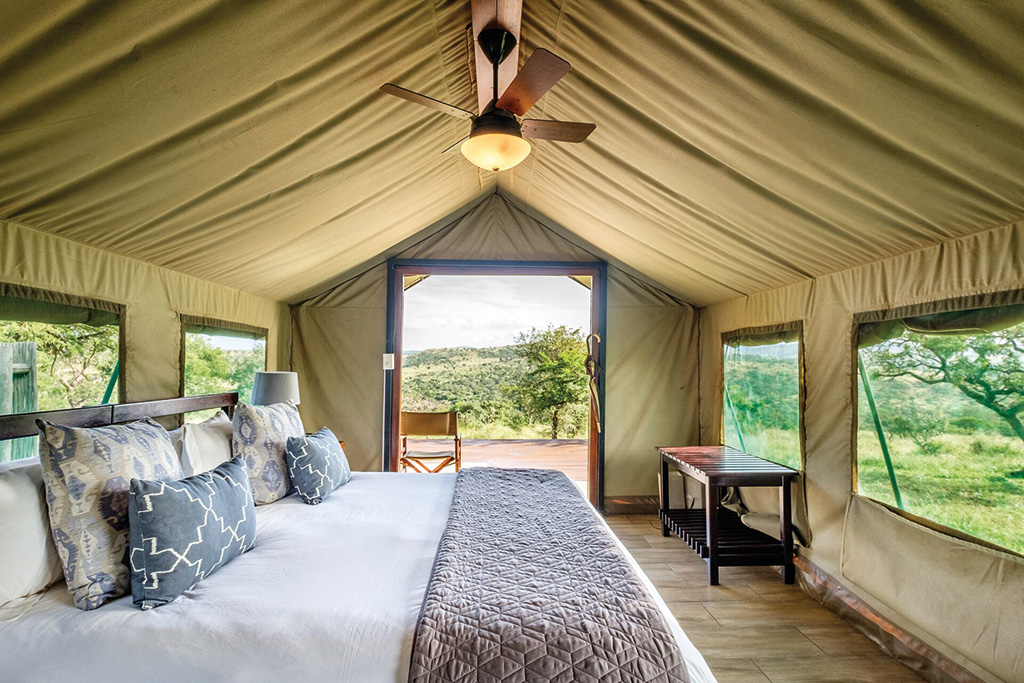
Mavela Game Lodge, Manyoni Private Game Reserve
Stay
The Africamps (since December 2019) glamping ‘tents’
accommodate five people, have a kitchen, large deck, braai and a wood-fired jacuzzi to top it off.
From R670 pp.
Whiteelephant.co.za
With an elevated view of the Pongola River and the wetlands below, Nkwazi Lake Lodge is a wondrful setting. The sturdy wooden chalets with private balconies are lovely and the swimming pool and delicious buffets round it off perfectly. From R1 345 pp.
Fact
The original Pongola Game Reserve was proclaimed in 1884 by
Paul Kruger, making it the world’s second-ever reserve, after Yellowstone in the United States. It was de-proclaimed in 1921 due to tsetse fly decimating cattle in the area.
pongolagamereserve.co.za
Babanango Game Reserve
Best For
Breathtaking views
With the backing of a German investor, the 22 000-hectare reserve has the luxury of profit not being the driving factor. Instead, conservation and community benefit are the focus. This, coupled with its setting – a jaw-dropping vista of grassland valleys and rocky outcrops that’s threaded by the White Umfolozi River – suggests Babanango has the potential to become one of the most striking reserves in the country.
Do
Morning and evening game drives often end up at one of the reserve’s lookout points. Guided walks are also available
for all guests.
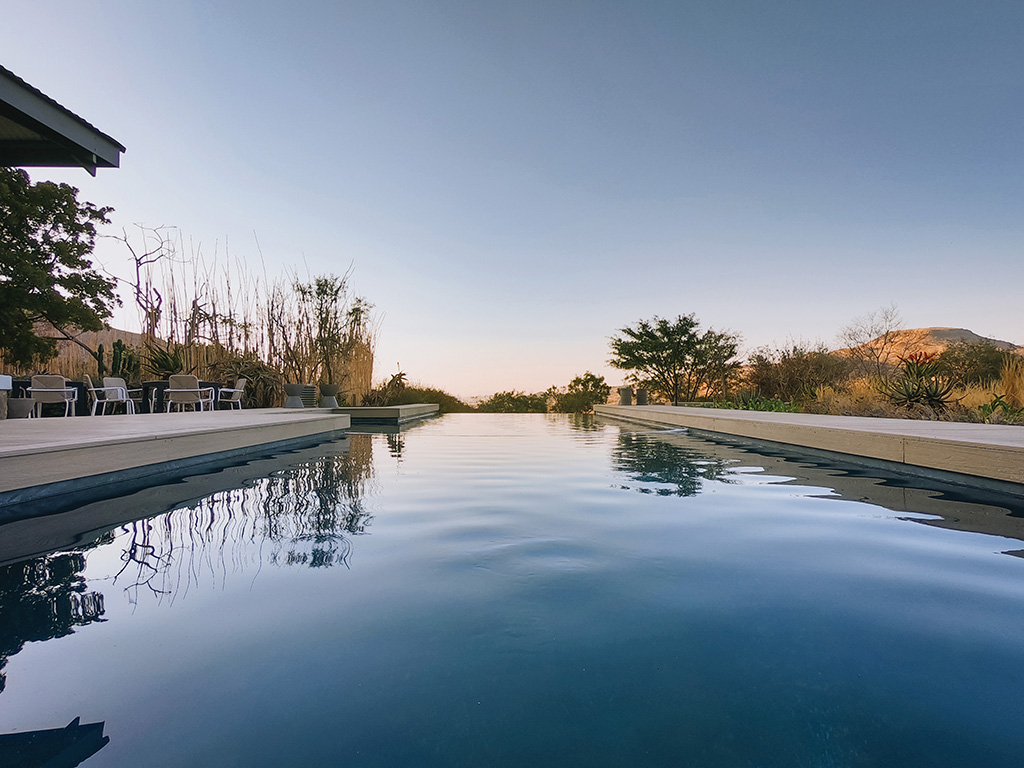
Babanango Game Reserve
Stay
The long infinity
pool at Babanango Valley Lodge is probably the best place to savour the view down the valley. The food here is outstanding and the main area is full of memorabilia of local history. It’s the perfect place to have a drink.
From R2 585 pp per night. Situated atop a mountain-side on the outer reaches of Babanango, Zulu Rock Lodge offers sweeping views from its seven stone-clad chalets, which accommodate up to 16 people. From R2 160 pp per night.
Fact
Babanango received a biodiversity score of 17/20, one of the highest in the province, when it was assessed by the KZN Biodiversity Stewardship Programme.
babanango.co.za
Online Trip Planner
Click on the QR code below



